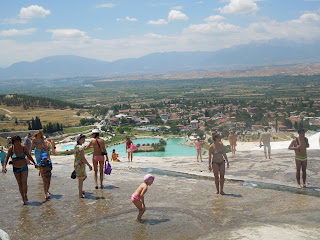The attraction that drew me to Turkey in the first place was Cappadocia, where it's moon-like landscape and cave churches/dwellings are fascinating not only visually but also for what they teach us about the early Christians that inhabited the area in the first millenium. I first viewed the landscape during a balloon ride early in the morning, so I'll begin with that, then add a couple other shots to give some flavor of the area.
One of the biggest attractions are the churches in which the early Christians lived. Learned that they churches had multiple levels, a kitchen and cooking area, a washing area, and the church worship area. Thus, the early Christians lived in their churches, carved out of these limestone formations. Some of the best of hundreds that survive are in the Cappadocia area, where the Greek Orthodox murals are visible. Since most people were illiterate at that time, the murals told the stories of the old and new testiments. Here are a couple shots of the churches, with the front of one collapsed, showing us some of the inside (photography was prohibited inside the churches).
Though they're a religious group. the Whirling Dervishes are seen by tourists as entertainment. Our guide, a knowledgeable and instructive fellow, warned us that it was a religious event, not a performance. They hold their event in a refurbished "caravanserai" (essentially, a combo of Motel 6 and truck stop for caravans on the silk road) and are worth the visit. They literally just "whirl" in costumes, broken up by bowing accompanied by music. Videos or photography during the performances was prohibited but I'll provide a couple shots of the site. Though "nominally" moslems, their philosophy and practices are more reminiscent of Buddhists or Hindu's.
Finally, while touring the museum accompanying Ataturk's mausoleum, ran across materials on the introduction of a new alphabet for Turkish, and later at the Anatolian Museum, a "rosetta" stone (much like the one I saw early on this trip at the British Museum) where the same message was carved in languages of the Egyptians (hieroglypics) and the Hittites, both contained within a stone "envelope."
Here's the "stone letter and envelope."
More another time but I have a 6 o'clock wake up call so I'll call it quits.














Thanks for the education!
ReplyDelete